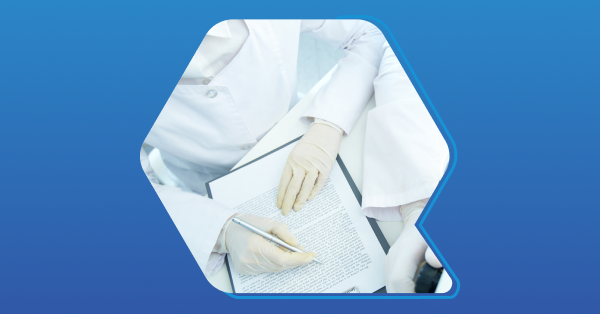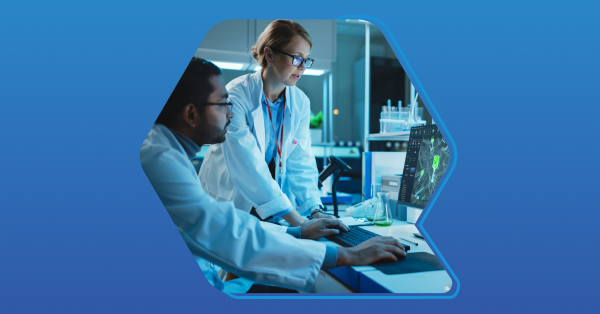The Ultimate Guide to Lab Sample Management for Modern Labs


In theory, sample management should be simple. You bring samples into your lab, organize them, perform tests on them, log results, and dispose of them.
But do you know which samples are being tested and where each sample is in your lab's testing process right now?
If that question raises your heart rate a bit, you’re not alone. Many labs rely on one person to coordinate lab operations and relegate things like sample management to outdated tools that don’t scale (like spreadsheets).
If you’re not using a high-quality Lab Information Management System (LIMS) as automated sample tracking software, keeping a handle on your samples is a herculean task. In this guide, we’ll show you how modern labs can scale faster and get more done by using a LIMS for sample management.
What is Sample Management?
Sample management refers to the systematic process of handling, organizing, and tracking samples in a lab. Whether they are biological, chemical, or physical, correctly managing samples is critical for modern labs.
Sample management tasks cover:
- Sample collection and receipt: This covers the initial tethering of samples in a lab, as well as proper labeling and documentation.
- Tracking and identification: Each sample should be given a unique identifier (such as a barcode) to track its location, status, and history in your lab.
- Storage and preservation: It’s important to store samples in the appropriate conditions (for example, in a controlled refrigerated environment) to maintain integrity.
- Quality control: Regular checks to ensure samples are not contaminated, degraded, or otherwise compromised is critical.
- Disposal or archiving: Once analysis is complete, samples are either safely disposed of according to regulatory guidelines or archived for future reference or reanalysis.
While labs can get by managing samples manually in spreadsheets, we wouldn’t recommend it; modern labs looking to scale (and get more done) are choosing a Laboratory Information Management System (LIMS) to automate many of these critical tasks.
A LIMS allows you to digitize the sample management process, automatically handle tracking and compliance, and keep a digital record for your entire team.
Why Proper Sample Management Matters
Sample management is a core piece of an organized and compliant lab. That’s because proper sample management helps to ensure the following:
- Accurate and reliable results for your lab
- Efficiency and productivity
- Compliance with regulations and standards
- Resources in your lab are optimized
- You are following safety protocols
- Customer experience and confidence in your lab
Ignoring errors and inefficiencies in your lab’s sample management opens you up to a host of risks. Gaps and errors in your process can lead to:
- Compromised data quality: If samples are mislabeled, contaminated, or improperly stored, the data generated from those samples can be unreliable or invalid.
- Delays and inefficiencies: Mismanaged samples can lead to significant delays in laboratory workflows, reducing overall productivity and efficiency.
- Regulatory and compliance issues: Non-compliance with regulatory standards can lead to legal consequences, including fines and revocation of licenses.
- Increased costs: Errors in sample management can lead to repeated tests and increased operational costs.
- Loss of reputation: Inaccurate results due to poor sample management can damage a laboratory's reputation and credibility.
- Safety risks: Improper handling and disposal of samples, especially hazardous or bio-hazardous materials, can pose significant health and safety risks.
Keys to Effective Lab Sample Management
If the previous section sounds daunting, here are a few keys to follow to ensure your lab is managing samples as effectively as possible. Take the time to review these guidelines and audit your lab’s processes to see where the gaps are:
- Standardization of procedures: Implement standardized protocols for sample collection, processing, storage, and disposal. Consistent procedures reduce the likelihood of errors and improve the overall reliability of results.
- Accurate labeling and identification: Each sample should be clearly labeled with a unique identifier. The use of barcodes, RFID tags, or other advanced identification methods can streamline tracking and reduce the chances of misidentification.
- Proper storage conditions: Store samples under appropriate conditions (temperature, humidity, light exposure, etc.) to maintain their integrity. Regular monitoring of storage environments is crucial.
- Quality control and assurance: Implement quality control measures to ensure that samples are not contaminated or degraded. This includes regular audits and validations of procedures and equipment.
- Data management and integration: Maintain comprehensive and accurate records for each sample, including its origin, handling history, and associated test data. Integration of this data with other laboratory information systems is vital for efficient data analysis and reporting.
- Training and competence of staff: Ensure that all personnel handling samples are adequately trained and understand the importance of proper sample management. Regular training and assessments are key.
- Efficient workflow design: Design laboratory workflows to maximize efficiency and minimize the risk of errors or sample mix-ups. This might involve process automation where feasible.
- Scalability as processes evolve: Your sample management system should be scalable to adapt to increasing workloads and flexible enough to accommodate new types of samples or changes in testing protocols.
If you’re looking at this list and wondering how you’ll manage all of this, we have a suggestion: use a LIMS.
LIMS platforms have become ubiquitous in modern labs. They allow labs to digitize and automate their processes while reducing errors. Not only does this provide a digital record for your lab, but it can also help you eliminate manual work and stay compliant.
How a LIMS Helps With Sample Management
A LIMS can be invaluable in automating and digitizing your processes for sample management. Here are the top ways that a LIMS can help your lab with sample management:
- Automated sample tracking
- Barcode integrations
- Data centralization
- Quality Control/Quality Assurance
- Inventory management
- Workflow management (with the ability to customize)
Automated Sample Tracking
The core of a LIMS is the ability to automate the tracking of samples throughout their lifecycle in your lab. This includes logging when samples are:
- Received
- Processed
- Stored
- Disposed of
This reduces hours of manual work on its own, but a LIMS can do so much more to automate and speed up your sample management processes.
Barcode Integration
Many LIMS integrate with barcode or RFID systems, allowing for easy labeling and identification of samples. This ensures each sample can be quickly and accurately identified throughout its time in the lab.
Data Centralization and Accessibility
The primary issue (among many others) with relying on spreadsheets for sample management is a lack of data centralization and scalability. Excel spreadsheets must be shared and backed up and can quickly become out of date. While Google Sheets offers a web-based solution, it pales in comparison to a cloud-hosted LIMS. A LIMS makes it easier for lab technicians to access and manage data wherever they are.
Quality Control and Compliance
A LIMS can help with maintaining quality control over samples and ensure compliance with various regulatory standards, such as GLP, GCP, or FDA regulations. QBench LIMS has a built-in QMS to provide a full suite of quality control features to ensure your lab stays within guidelines.
Inventory Management
Another core function of a LIMS is managing inventory: from managing samples to monitoring expiration dates, a LIMS can help your lab keep track of its samples, reduce waste, and save countless hours of manual work.
Workflow Management
It optimizes lab workflows by scheduling sample processing and testing, thereby improving lab efficiency and productivity.
Modern LIMS solutions are scalable and can be customized to meet the evolving needs of a laboratory. They can handle increasing volumes of samples and adapt to new tests or technologies.
As you can see, a LIMS can be extremely beneficial in automating your sample management process. Read on as we walk through the best LIMS for sample management.

Best LIMS for Sample Management
Here are the top three LIMS on the market for sample management. Many LIMS will include sample management as a core feature, but it’s important to choose the right platform for your lab.
QBench
QBench is a fantastic option for labs of all sizes and many industries looking to get more done and scale.
Boasting powerful automation features, the ability to configure your LIMS to adapt to your lab's needs, and a growing list of integrations, it’s no wonder that QBench was awarded numerous badges in 2023 from G2. Here’s a sample of what customers are saying about QBench:
“QBench helps my lab to function in an organized fashion. We can keep track of all samples throughout their lifecycle, including their physical location from receipt to archived in storage, as well as which stage they are at within our workflows. Our lab can customize features that are specific to our lab, allowing our processes to be accurately documented in extreme detail.”
“Qbench can categorize the hundreds of samples we receive weekly in a simple easy-to-read way. It makes looking up information on samples only a few clicks away.”
“QBench is excellent in that it takes information and organizes it in a way that makes it easy to understand. It can sort the data that's been given and create filters where necessary. Managing samples and the associated data is simple, allowing for a more automated workflow and reducing human error. Tracking data is quick and reliable, increasing efficiency. It's also user-friendly and appealing to the eyes.”
It’s no surprise that QBench leads G2 in North America with a G2 Satisfaction Score of 95/100 and has earned 4.6/5 stars overall.
LabWare
LabWare is a good option for labs looking to digitize their operations thanks to their built-in ELN and LIMS automation features. LabWare boasts many automation capabilities along with QA/QC features and instrument integrations. Labware is well-reviewed on G2 with 4.5/5 stars.
Lockbox LIMS
Lockbox LIMS (by Thirdwave Analytics) is a well-regarded player in the LIMS space. Lockbox LIMS boasts a series of features that help labs digitize and automate their operations. Lockbox LIMS is built as a Salesforce app and is available on the Salesforce AppExchange. Lockbox LIMS is well-rated on G2 with 4.9/5 stars.
QBench LIMS consistently earns high marks, for an in-depth comparison you can review the similarities and differences between these 3 platforms on G2.
Ready to Scale Up Your Sample Management? See How a LIMS Can Help
For labs looking to save time, get more done, and scale, proper sample management is a must.
And to do sample management right, and at scale, there's no better tool than a LIMS. But of the LIMS on the market, which will you choose?
You need one that fits your budget, includes the right features, supports your workflows, and can adapt as your needs change. To help you make the right choice, download the free guide to choosing the right LIMS by filling out the form below. You will learn the types of LIMS available, essential features to look for, and how to evaluate vendors.









